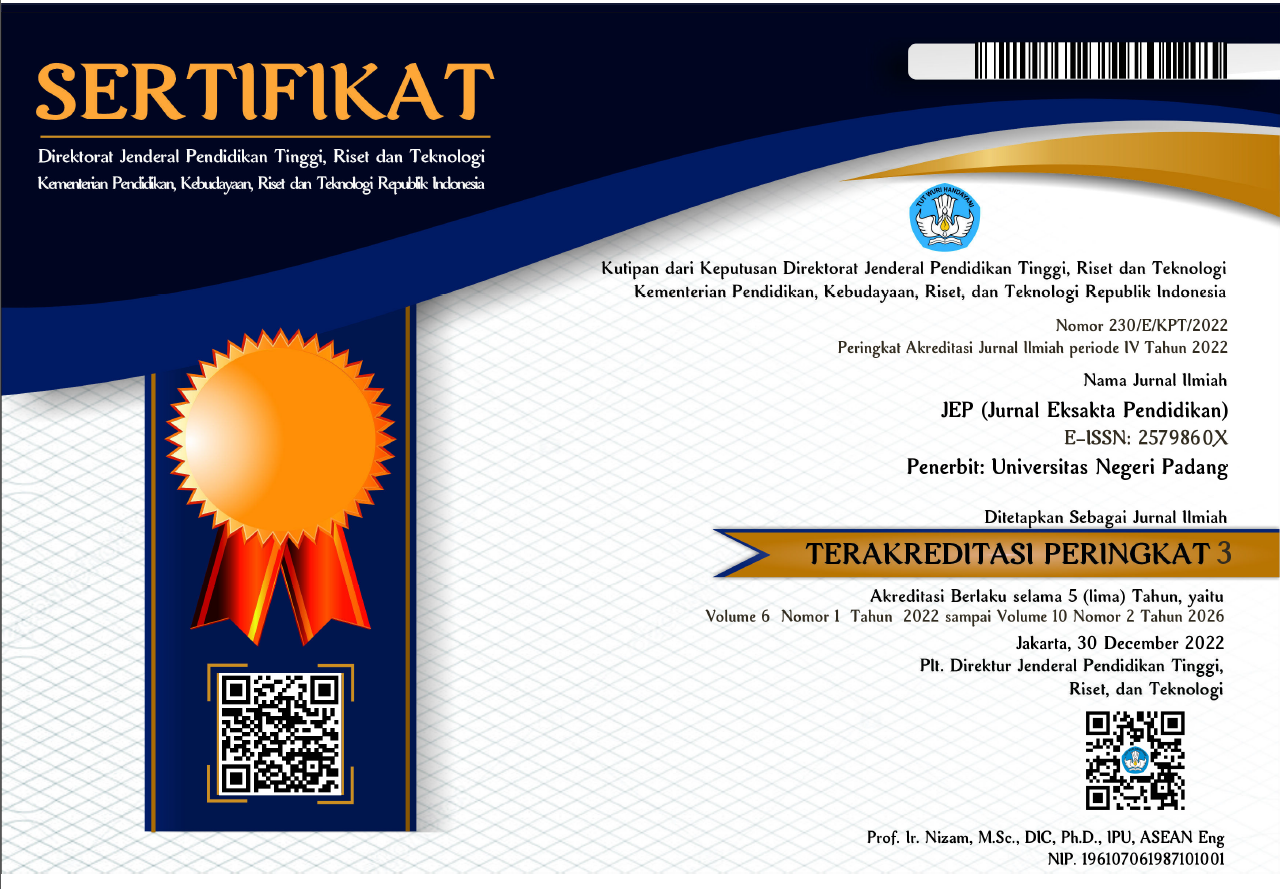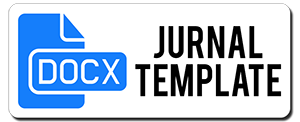The Influence of the R2L Learning Model on the Material of the Human Digestive System on Students’ Scientific Literacy
Abstract
2018 PISA results show that Indonesia is ranked 71st out of 77 countries in the world. While Indonesia has been successful in increasing the access of 15-year-olds to the school system, greater efforts are still needed to educate them so that the percentage of low-achieving students is kept as low as possible. Based on the results of observations made, students' scientific literacy at SMP Negeri in Bukittinggi is still relatively low. This research was a quasi-experimental study with a non-equivalent control group design which aims to determine the scientific literacy profile of students using the Reading to Learn (R2L) model. The R2L model has a main focus on teaching students to read texts and then gain a deeper understanding of the contents of the reading and rewriting what they have learned (note-taking). Based on the results of statistical analysis, the data is normally distributed and homogeneous so that a parametric test (T-test) is carried out. The results of the calculation of the T-test obtain a value of 0.05, thus H0 is rejected and H1 is accepted. This shows that there is an influence of the Reading to Learn (R2L) model on the digestive system material on the scientific literacy skills of junior high school students.
Downloads
References
Alfa, D. S., Irsyad, M., Anwar, M., Adisva, Q. N. F., & Abdullah, H. (2022). Student Literacy Competence in Science Learning in Junior High Schools with the Reading to Learn Model. AL-ISHLAH: Jurnal Pendidikan, 14(2), 1607–1616.
Ashel, H., & Riandi, R. (2022). Inovasi Metode Pembelajaran: Metode Eksperimen Bauran (Real-Virtual) Berbantuan Software Analisis Video. Jurnal Eksakta Pendidikan (JEP), 6(1), 11–19.
Asrizal, A., Amran, A., Ananda, A., Festiyed, F., & Sumarmin, R. (2018). The Development of Integrated Science Instructional Materials to Improve Students' Digital Literacy in Scientific Approach. Jurnal Pendidikan IPA Indonesia, 7(4), 442–450.
Firmonia, N. A., Asrizal, A., & Mufit, F. (2020). Pengembangan Bahan Ajar Fisika Materi Fluida Terintegrasi Literasi Baru dan Bencana untuk Meningkatkan Hasil Belajar Siswa Kelas XI. Pillar of Physics Education, 13(1), 9-16.
Hermansyah, H. (2020). Pembelajaran IPA Berbasis STEM Berbantuan ICT dalam Meningkatkan Keterampilan Abad 21. Jurnal Ilmiah Profesi Pendidikan, 5(2), 129–132.
Husein, R., Sembiring, M., Wulandari, S., Andary, S., & Rahman, Ma. (2022). Reading to Learn (R2L) Model to Activate Students on Reconstruction Short Story. Budapest International Research and Critics in Linguistics and Education (BirLE) Journal.
Husein, R., Siregar, M., & Pulungan, A. H. (2022). Meningkatkan Kompetensi Literasi Teks Transaksional Lisan Berbasis Kearifan Lokal Para Guru Bahasa Inggris Melalui Model Pembelajaran Reading to Learn (R2L).
Mardhiyah, R. H., Aldriani, S. N. F., Chitta, F., & Zulfikar, M. R. (2021). Pentingnya Keterampilan Belajar di Abad 21 Sebagai Tuntutan dalam Pengembangan Sumber Daya Manusia. Lectura: Jurnal Pendidikan, 12(1), 29–40.
Merta, I. W., Artayasa, I. P., Kusmiyati, K., Lestari, N., & Setiadi, D. (2020). Profil Literasi Sains dan Model Pembelajaran dapat Meningkatkan Kemampuan Literasi Sains. Jurnal Pijar MIPA, 15(3), 223–228.
Muttaqiin, A., Ananda, A. S. D., Aulia, P., Razi, P., Yusefarina, Y., & Yanuarsi, L. (2022). Profile of Students’ Character in the Reading to Learn (R2L) Model in Improving Scientific Literacy Skills. AL-ISHLAH: Jurnal Pendidikan, 14(4), 5431–5442.
National Center for Education Statistics (NCES). 2012. Highlights From TIMSS 2011: Mathematics and Science Achievement of U.S. Fourthand Eighth-Grade Students in an International Context. Washington, DC: U.S. Department of Education.
Narut, Y. F., & Supardi, K. (2019). Literasi Sains Peserta Didik dalam Pembelajaran IPA di Indonesia. JIPD (Jurnal Inovasi Pendidikan Dasar), 3(1), 61–69.
Ningrum, M. A. B., & Rahmi, Y. L. (2021). Analisis Kebutuhan Penilaian Capaian Literasi STEM Peserta Didik dalam Pembelajaran Biologi. Jurnal Eksakta Pendidikan (Jep), 5(2), 156–163.
OCED. (2019). Pisa 2018 Results Combined Executive Summaries Volume I, II & III. www.oecd.org/about/publishing/corrigenda.htm.
Oktavia, R., & Aulia, P. (2023). Reading to Learn Models: A Strategy to Improve Student Science Literacy About Addictive, Additive, and Psychotropic Substances. IJIS Edu: Indonesian Journal of Integrated Science Education, 5(1), 1–5.
Pratiwi, S. N., Cari, C., & Aminah, N. S. (2019). Pembelajaran IPA abad 21 dengan Literasi Sains Siswa. Jurnal Materi Dan Pembelajaran Fisika, 9(1), 34–42.
Robbia, A. Z., & Fuadi, H. (2020). Pengembangan Keterampilan Multimedia Interaktif Pembelajaran IPA untuk Meningkatkan Literasi Sains Peserta Didik di Abad 21. Jurnal Ilmiah Profesi Pendidikan, 5(2), 117–123.
Rose, D., & Martin, J. R. (2012). Learning to Write, Reading to Learn: Genre, Knowledge, and Pedagogy in The Sydney School. Equinox London.
Sadia, W. (2013). Model Pendidikan Karakter Terintegrasi Pembelajaran Sains. JPI (Jurnal Pendidikan Indonesia), 2(2).
Sari, S. Y., Sundari, P. D., Jhora, F. U., & Hidayati, H. (2020). Studi Hasil Bimbingan Teknis Pengembangan Perangkat Pembelajaran Berbasis Keterampilan Abad-21 dalam Rangka Penerapan Program Merdeka Belajar. Jurnal Eksakta Pendidikan (JEP), 4(2), 189–196.
Setiawan, A. M., Fardhani, I., Mulyati, Y., Chandra, S., Wulandari, T., & Nida, S. (2022). Sosialisasi Literasi Sains Berdasarkan Kerangka Pisa Untuk Para Pendidik IPA Di Indonesia. Journal of Social Outreach, 1(2), 57–67.
Shaffer, J. F., Ferguson, J., & Denaro, K. (2019). Use of the Test of Scientific Literacy Skills Reveals That Fundamental Literacy Is an Important Contributor To Scientific Literacy. CBE—Life Sciences Education, 18(3), ar31.
Sugiyono. (2017). Metode Penelitian Pendidikan (Pendekatan Kuantitatif, Kualitatif, dan R&D). Alfabeta.
Sujarweni, V. W. (2022). SPSS Untuk Penelitian. Pustaka Baru Press.
Sundayana, R. (2016). Statistikan Penelitian Pendidikan. ALFABETA.
Werimon, S., Damopolii, I., Nunaki, J. H., & Pendidikan Biologi, J. (2017). Pengaruh Model Pembelajaran STAD Dipadu Media Pembelajaran Komik Materi Sistem Pencernaan Manusia terhadap Hasil Belajar Siswa. In JEP (Vol. 1).
Widana, I. W., & Muliani, P. L. (2020). Uji Persyaratan Analisis. Klik Media.
Wijaya, E. Y., Sudjimat, D. A., Nyoto, A., & Malang, U. N. (2016). Transformasi pendidikan abad 21 sebagai tuntutan pengembangan sumber daya manusia di era global. Prosiding Seminar Nasional Pendidikan Matematika, 1(26), 263–278.
Wulandari, A. T., & Jahro, I. S. (2023). Pengaruh Metode Reading to Learn dan Rangkuman Terhadap Hots-Literacy Sains Siswa Pada Materi Laju Reaksi. Jurnal Pendidikan Sosial Dan Humaniora, 2(1), 289–295.
Yogica, R., & Hasanah, J. (2019). Analisis Kesiapan Peserta Didik SMA Negeri 8 Padang Menghadapi Revolusi Industri 4.0. Jurnal Eksakta Pendidikan (JEP), 3(2), 176-183.
Yulianeta, M. D. I., Lugijana, K. A. A., Seftiana, R., & Damayanti, D. (2022). Implementing Reading to Learn (R2L) Pedagogy to Help Indonesian Junior High School Students Generate News Report Text. PAROLE: Journal of Linguistics and Education, 12(1), 130–137.
Yuliati, Y. (2017). Literasi Sains dalam Pembelajaran IPA. Jurnal Cakrawala Pendas, 3(2).
Copyright (c) 2023 Khairil Arif, Olyivia Retdwina Rusma, Trio Mahendro Alam Sad

This work is licensed under a Creative Commons Attribution 4.0 International License.

This work is licensed under a Creative Commons Attribution 4.0 International License.




_(2579-860X).png)
_(2614-1221)1.png)




